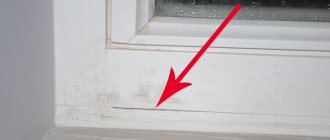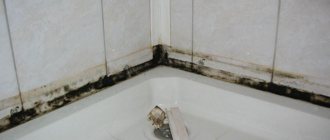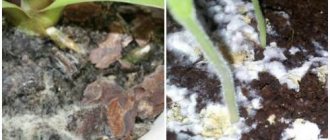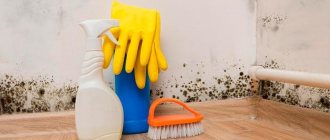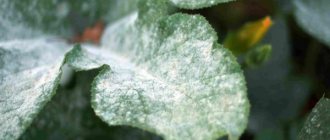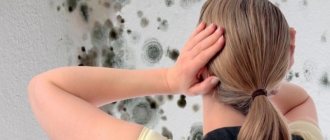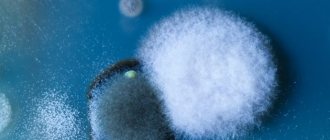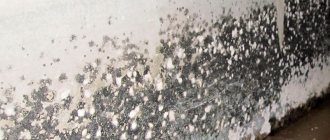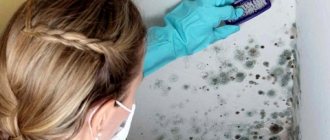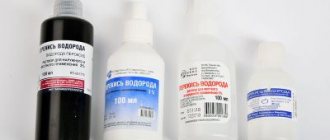This does not look aesthetically pleasing, leads to the destruction of materials, and is also quite dangerous for human health, because colonies of fungi can cause various diseases.
The causes of mold are commonplace: heat, excess moisture and lack of regular ventilation. The fungus is actively growing, occupying large areas.
You can stop this process without significant losses yourself by using complex methods of influence. We will tell you how to remove mold from plastic and wooden windows in this article.
Risk factors
There are several reasons why mold appears on plastic windows:
- The installation of double-glazed windows was carried out in violation of technology.
- High level of humidity in the room.
- Lack of ventilation.
- The presence of a wide window sill, which impedes the movement of warm air currents tending to the window.
- Insufficient thermal insulation of the walls of the house.
These and other factors provoke the development of fungus on windows, providing favorable conditions for the active growth and activity of microorganisms. It should be borne in mind that at the initial stage the problem may not have visual manifestations. Even before brown, green and black spots appear on the windowsill and slopes, a characteristic musty smell appears in the room, which no air freshener can cope with.
Causes of mold on windows
Mold spores are suspended in the air. When it hits a surface favorable for development, it begins to grow at tremendous speed. Black mold is dangerous to human health. It can cause severe allergic reactions and other serious illnesses. In addition, as mold grows, it destroys the surface of the walls. It spoils plastic, wood, plastered walls, brick, concrete.
It happens that mold begins to appear on window slopes, rubber seals, window sills and even glass. Conventional detergents help get rid of these black spots only for a while, and then the mold appears again. This happens because the very cause of the fungus has not been eliminated. When choosing a window, you should take into account that, other things being equal, mold spores are much more likely to settle on plastic surfaces. But wooden windows with plastered slopes will be more resistant to fungus.
But if a PVC window is already installed, then do not rush to change it. Firstly, you can remove the plastic slopes and plaster the walls. And secondly, it is necessary to create conditions in the apartment that are unfavorable for the development of mold. It begins to actively multiply at high humidity in poorly ventilated areas (which is why mold is most often found in bathrooms). It will be enough to eliminate these two causes of mold to get rid of this problem.
Step by step solution to the problem
You need to understand that mold on plastic windows is not enough to simply wash off. Solving the problem must be approached comprehensively, otherwise there is a risk that the fungus will soon return again. To prevent this from happening, we must call on all available methods and means to help.
Eliminate the root cause
The fight against mold should always begin with eliminating the root cause - the source of high humidity. Otherwise, all efforts will be in vain, and the fungus will appear with enviable regularity.
First of all, it is necessary to determine why the windows become moldy and carefully evaluate their condition. If condensation regularly forms on them, the installation was carried out in violation of the process technology. Poor installation leads to deformation and displacement of the frame, errors in measurements lead to insufficient thermal insulation. Constant humidity is an ideal environment for fungi and other microorganisms, so if the source of dampness is not eliminated, it will not be possible to completely get rid of mold on windows. The best option in this case is to replace or reinstall double-glazed windows.
If during the inspection of the window no defects are identified, the problem is in the room itself. If the humidity level in the room exceeds 60%, it is necessary to immediately reduce the levels and establish air exchange.
Cleaning stains
After the source of dampness has been eliminated, you can begin to remove mold stains from the surface of window frames, window sills and slopes. This must be done carefully, without missing a single centimeter, since the spores are very tenacious and love secluded places. Superficial treatment will not save the situation - the fungus will grow again.
The most difficult thing to eliminate is mold that has formed on window slopes. As a rule, they are made of plasterboard - a porous material that turns into a real breeding ground for pathogenic microorganisms. In this case, there is no alternative; a complete replacement of the finishing sheets will be required, followed by treating the wall surface with special antifungal compounds. The exception is plastic slopes - they can be washed using the same means as the rest of the window parts.
You can remove black stains using accessible and inexpensive household chemicals. They can be found at any hardware store. The main thing to remember is that these substances are quite aggressive, so you need to take precautions when working with them. Among the most effective are:
- Chlorine-containing preparations. They help both get rid of mold on the windowsill and window frame, and disinfect the room. They should be diluted with water in a ratio of 1:5, after which the mold should be thoroughly washed with a sponge soaked in the solution. When working with bleach, you must protect your hands with gloves and use a respirator.
- Copper sulfate is an effective remedy that can be found in gardening shops and supermarkets. With its help, it is easy to wash even extensive stains; you just need to apply it to a sponge and wipe the surface affected by the fungus. As in the case of bleach, you should protect your hands and respiratory tract from contact with the substance, and the room should be thoroughly ventilated.
- Baking soda is a remedy that does not give the fungus a single chance. You will need to mix 100 g of powder with 300 ml of water, stir thoroughly, then apply the solution to the stain using a sponge and wipe.
- Table vinegar will also help get rid of mold on windows. First, you need to wipe the stains with a dry cloth, and then apply undiluted vinegar to them. After two hours, surfaces should be rinsed with clean water. If the contamination cannot be removed the first time, the procedure can be repeated.
Cleaners such as Dufa, Vincents and Polyline are not recommended as PVC will turn yellow on contact with them.
How to remove mold from plastic windows
All procedures can only be carried out if the primary source of dampness has been eliminated. Otherwise, mold control will not be effective. There are several physical methods for removing mold:
- Irradiation of fungal lesions using a special professional apparatus;
- Mechanical cleaning of windows using a sharp scraper;
- Heat treatment of fungus-affected areas using a directed stream of hot air;
But there are also chemical methods:
- Special long-acting fungicides are used to treat window openings. They kill already matured fungal spores and prevent the development of mold in the area of slopes and installation joints for at least five years;
- Certain types of fungicides can be added to detergents, so they are used as part of monthly window cleaning. It is necessary to prepare a solution for treating the window surface strictly before the procedure itself;
If there is no fungicide, it is recommended to use any chlorine-containing product.
Additional measures
To prevent mold from reappearing on windows, windowsills and slopes, fungicides – substances that stop the growth of mold fungi – should be used in combination with detergents. These include “Biocid”, “Clotrimazole”, “NEOMide” and other drugs. You can buy them at your nearest pharmacy and use them according to the instructions on the package.
We recommend:
How to clean nubuck shoes at home
Coating the wall areas adjacent to the window with special waterproofing agents - mastic or rubber-based primer - will help to consolidate the result. This will create a moisture-proof barrier that will reliably protect the room from moisture from the outside.
Important! To apply the waterproofing compound evenly, use a wide silicone brush.
Technology to help
An ultraviolet lamp also helps fight mold that appears on window frames, window sills and walls. Studies have shown that its rays effectively destroy almost all types of pathogenic microorganisms, which include fungal spores. Therefore, such a household appliance can be used regularly for preventive purposes. The main thing is to follow the precautions prescribed in the instructions. In particular, do not stay in the room while the device is operating and ventilate the room after treatment is completed.
Ozonizer
An ozonizer is another indispensable assistant in the fight against germs, mold and dust mites. Within an hour of operation, the device is able to completely clean the room of pathogenic organisms. But it should be remembered that ozone in high concentrations has a poisonous effect, so you should not be near a working device, and after finishing the treatment, the room must be thoroughly ventilated.
Surface cleaning
The material of the slopes where moldy spots have formed is of great importance. If plastic is used, the plank is disassembled and the wall underneath is completely disinfected. Plasterboard panels are replaced with others. The fungus has already managed to penetrate the pores of such material, so it will not be possible to completely remove the colony.
Use a stiff brush to get rid of mold and completely clean it from surfaces, frames and walls. Then you need to treat the wall and the double-glazed window with a chlorine-containing substance, first protecting your hands with gloves.
Antiseptic treatment
Products for antiseptic treatment are purchased ready-made at a hardware or hardware store. Typically, they use copper sulfate or chlorine as the active ingredient. There are several options for making your own disinfectant composition.
First option:
- 200 ml acetic acid concentration 70%;
- 200 ml boric acid;
- 1 liter of water.
Second option:
- 100 ml copper sulfate;
- 100 ml sodium fluoride;
- 1 liter of water.
Third option:
- 1 part bleach;
- 1 part copper sulfate;
- 5 parts water.
Important! Before processing, gloves are put on your hands. Then the prepared wall is treated with an antiseptic using a brush. After finishing work, be sure to ventilate the room.
Consolidate the result
To prevent reoccurrence of mold, waterproof the surface. The slope is covered with construction mastic, creating a moisture-proof barrier on the wall. It will last for several years.
Preventive actions
To avoid the reappearance of mold on plastic windows and other surfaces, be sure to ensure good air circulation in the room. It will be necessary to establish a ventilation system, as well as remove all sources of moisture - indoor flowers that require regular watering, containers with water, wet laundry. And, of course, you need to repair the heating system if even a minor leak is discovered. Only by eliminating all negative factors can you count on long-term results.
Rate this post
